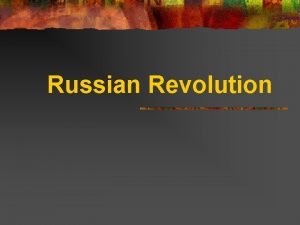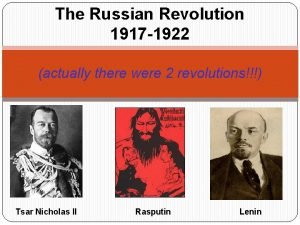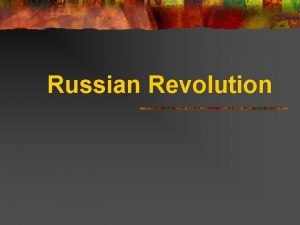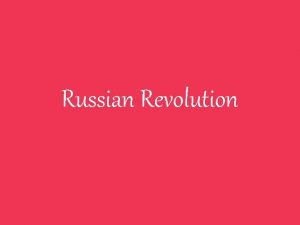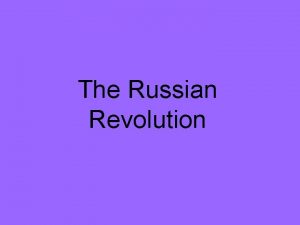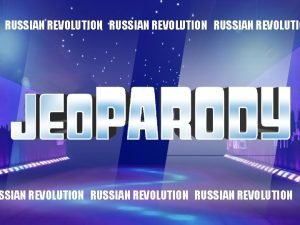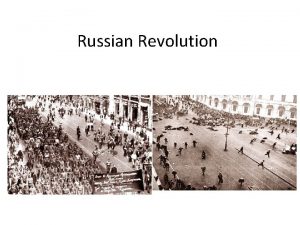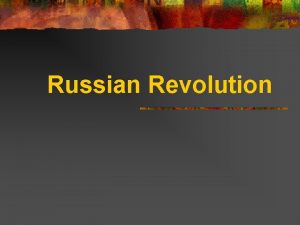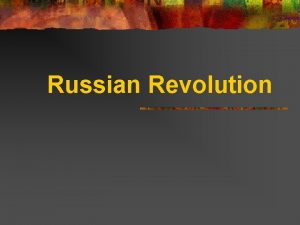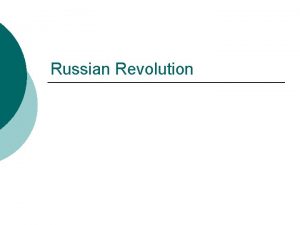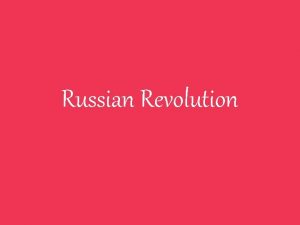The Russian Revolution WARMUP Recall what was discussed















- Slides: 15

The Russian Revolution

WARM-UP Recall what was discussed regarding Russia and her involvement in WWI.

The Reign of Nicholas II • Conditions – Tsar Nicholas II ruled as an absolute monarch – naïve to the dissatisfaction in society • Results – Russia politically unstable – Liberals wanted a democratic government – Repressed minorities wanted independence – Peasants wanted land reform; workers wanted better working conditions – Military lost Russo-Japanese War

• The Tsar’s police killed hundreds of workers marching peacefully in St. Petersburg- Bloody Sunday • Results – Revolts and strikes spread throughout Russia – Radicals organized workers’ councils (soviets) – Tsar concedes democratic powers, in form of legislature called the Duma – Tsar’s minister attempts land reform and is assassinated The 1905 Revolution

World War I in Russia • Conditions – Russia honors alliances and joins World War I – Tsar Nicholas II takes personal command of the army – Army suffers many military defeats • Results – Discontent of soldiers, peasants, and workers – Russia suffers most devastating losses in World War I


• March 8, 1917 • Women’s march for “bread and peace” turns into widespread revolt in St. Petersburg – Joined by striking factory workers and mutinous army troops • The Tsar dissolved the Duma • Two rival centers of authority emerge – Temporary committee of the Duma, led by Alexander Kerensky, made of members who refuse to dissolve – Soviet Workers’ and Soldiers Deputies: council representing the army and labor leaders The March Revolution

• March 15, 1917: Tsar abdicates the throne due to lack of support • Provisional Government out of the old Duma – Russia now a republic • Karl Marx-influenced Vladimir Lenin, Josef Stalin, and Leon Trotsky return from exile – Begin to steer the new govt. towards socialism – Call themselves “Bolsheviks” • Early attempt to overthrow the govt. promises “Peace, Land, and Bread” – Peace for Soldiers, Land for Peasants, Bread for Workers – Attempt was unsuccessful

Lenin & the Great October Revolution • Lenin leader of the Bolshevik party – Protests Provisional Government as it continues to fight in WWI – Gathers more support as casualties at the front mount • Bolshevik Revolution begins October 25, 1917 – Trotsky’s Red Guard seizes most of St. Petersburg – Lenin proclaims socialist state, nationalizes all land – Communists or Soviets seize control of the govt. , throwing out the Provisional Government – Treaty of Brest-Litovsk, 1918 • Ends Russia’s involvement in WWI • Lost territory, population, & 80% of coal & iron reserves • Later nullified by Treaty of Versailles

The Great Civil War • 1918 -1920 • A counter-revolution of Anti-Bolsheviks – Monarchists, aristocrats, and aided by Britain, France, U. S. , and Japan – Called the “Whites” or Mensheviks • “Red” army led by Leon Trotsky • Bolsheviks initially in trouble with Whites holding 8 million square miles • Entire royal family killed by Bolsheviks • Ultimately the Red army won control of country • 13. 6 million Russians killed during the civil war & agricultural and industrial production lowered

The Soviet Union Under Lenin • Effects of Communism on Russia – WWI and Civil War - 1/2 of its population dead – By 1922, wages dropped to 1/10 of prewar levels – Western nations blockaded Russia – Eastern Orthodox Church Restricted – New education programs to promote literacy – Country renamed USSR in 1923 • Lenin concerned new socialist experiment would fail – Developed New Economic Policy (NEP) “taking one step backward to go two steps forward. ” – The NEP helped to jump start the economy with small-scale capitalism – Lenin’s new goal: to bring about a classless society

The Soviet Union Under Stalin • Lenin’s death in 1924 led to a power struggle between Trotsky, a military leader and Stalin, a political leader • Stalin won and forced Trotsky into exile • Stalin became a totalitarian dictator

Stalin’s Revolution • Resistance to the programs and the failure • Five-Year Plans: Stalin’s of collectivization led to plan to force rapid the deaths of millions industrialization starting in through execution and 1928. Russia was famine. successful, but at huge social and environmental costs. • Collectivization of Agriculture: All land was taken by the government and peasant farmers were forced to move onto communal farms with modern machinery. Each collective owed a majority of their harvest to the government to feed workers.

Stalin’s Great Purge • To prevent resistance and rebellion against his policies, Stalin founded the NKVD, a secret police force. • Stalin “purged” the government, military, and Communist Party of millions of members through expulsion and execution. • Millions of regular people were sentenced to death or sent to gulags, labor camps in Siberia where a million people died each year from starvation and exposure. • The death of so many created opportunities for others, and their support cemented Stalin’s power.















